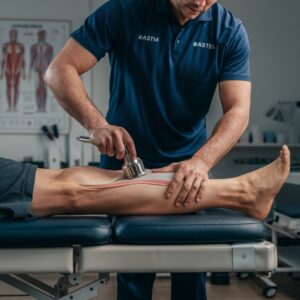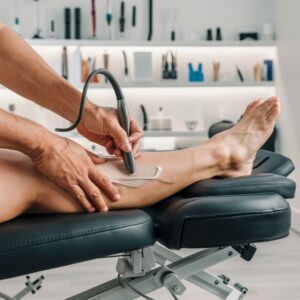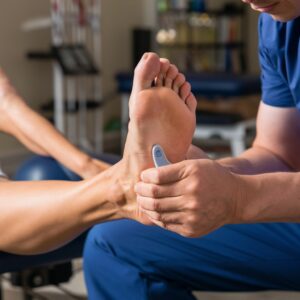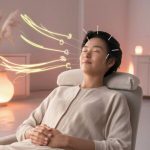Enhancing Recovery with Instrument-Assisted Soft Tissue Mobilisation
Healthcare practitioners employ a manual therapy technique known as Instrument-Assisted Soft Tissue Mobilisation (IASTM) to effectively treat soft tissue injuries and musculoskeletal issues. This method utilises specially designed instruments, typically crafted from stainless steel, to pinpoint and rectify areas of compromised soft tissue function. The devices apply targeted pressure and friction to the affected areas, promoting the dissolution of scar tissue, adhesions, and restrictions within the fascia.
IASTM, or Instrument-Assisted Soft Tissue Mobilisation, is a minimally invasive technique used to treat various conditions, including tendinitis, muscle strains, ligament sprains, and myofascial pain syndrome. Additionally, it has shown effectiveness in addressing chronic conditions like plantar fasciitis, carpal tunnel syndrome, and tennis elbow. The primary objectives of IASTM are to improve soft tissue function, reduce discomfort, and restore normal movement patterns.
The main objective of IASTM is to offer patients lasting relief from symptoms by targeting the underlying causes of soft tissue dysfunction. IASTM is applicable to a wide range of patients and is frequently incorporated into holistic treatment plans in conjunction with various therapeutic methods. Although IASTM has become increasingly popular in recent years, it is important to note that the success of this technique can be influenced by individual conditions and patient characteristics.
Main Points
- IASTM is a hands-on therapeutic approach designed to address soft tissue injuries and musculoskeletal disorders. The process entails the mobilisation and manipulation of soft tissue through the use of specially crafted tools.
- IASTM offers several advantages for recovery, such as enhanced blood circulation, decreased pain and inflammation, greater range of motion, and faster healing of soft tissue injuries.
- IASTM facilitates the healing of soft tissues by effectively breaking down scar tissue, stimulating collagen production, and enhancing the alignment and function of tissues.
- IASTM is essential in rehabilitation and injury prevention, effectively targeting soft tissue restrictions, enhancing tissue quality, and improving overall movement patterns.
- Techniques and tools frequently utilised in IASTM encompass scraping, cross-friction massage, and instruments like Graston and HawkGrips.
- When utilising IASTM, it is essential to take precautions such as steering clear of regions with open wounds, infections, or acute inflammation. Additionally, ensuring proper training and technique is crucial to avoid any potential tissue damage.
- Incorporating IASTM into a holistic recovery strategy entails blending it with additional techniques like exercise, stretching, and manual therapy to tackle the root causes of soft tissue dysfunction and foster sustainable recovery.
 The Benefits of IASTM for Recovery
The Benefits of IASTM for Recovery
Analysing Scar Tissue and Adhesions
IASTM provides a notable benefit in the healing process of soft tissue injuries and musculoskeletal issues by effectively breaking down scar tissue and adhesions that may form in the soft tissues after an injury. Adhesions may limit mobility and lead to discomfort, rigidity, and diminished functionality. Utilising IASTM to address these adhesions enables healthcare professionals to assist patients in restoring normal movement patterns and alleviating pain.
Enhancing Circulation and Facilitating Recovery
One more advantage of IASTM is its capacity to enhance blood circulation to the targeted region. Enhanced blood circulation facilitates the healing process by supplying vital nutrients and oxygen to the tissues while effectively eliminating waste products and toxins. This can aid in diminishing inflammation, swelling, and discomfort, while also promoting the body’s inherent healing mechanisms.
Enhancing Collagen Production and Promoting Tissue Repair
Moreover, IASTM can promote collagen production, a crucial factor in the repair and regeneration of damaged tissues. This may result in a quicker and more efficient recovery from soft tissue injuries and musculoskeletal conditions.
How IASTM Enhances Soft Tissue Healing
IASTM promotes the healing of soft tissues by activating the body’s natural healing processes and reducing the barriers that impede recovery. Soft tissue injuries may result in the development of scar tissue and adhesions as a consequence of the body’s natural healing mechanisms. While these tissues are essential in the initial phases of wound healing, improper positioning or restriction of movement can lead to complications.
IASTM aids in the realignment of scar tissue and the breakdown of adhesions, fostering improved tissue healing and reduced discomfort. IASTM, or Instrument-Assisted Soft Tissue Mobilisation, effectively breaks down scar tissue and adhesions while improving the flexibility and suppleness of soft tissues. This approach can promote the recovery of normal movement patterns and reduce the chances of re-injury.
Restoring flexibility, range of motion, and strength to the soft tissues is crucial for a complete recovery, and IASTM offers effective assistance in this process. Furthermore, IASTM can effectively reduce inflammation in the affected area. Inflammation is a natural response to injury; however, an excessive or prolonged inflammatory reaction can impede the healing process.
Instrument-Assisted Soft Tissue Mobilisation (IASTM) is a therapeutic approach designed to promote tissue healing through enhanced blood circulation and reduced inflammation. Enhancing blood circulation, IASTM guarantees that the impacted tissues obtain the essential nutrients and oxygen required for a swift recovery. This knowledge equips you, the healthcare expert, to make well-informed decisions regarding the treatment of soft tissue injuries.
 The Role of IASTM in Rehabilitation and Injury Prevention
The Role of IASTM in Rehabilitation and Injury Prevention
IASTM, or Instrument-Assisted Soft Tissue Mobilisation, plays a crucial role in the rehabilitation process. This method effectively restores normal function to the soft tissues, addressing the source of pain and impaired function. Rest and traditional rehabilitation methods frequently fall short in fully addressing soft tissue injuries. IASTM provides a targeted approach for addressing scar tissue, adhesions, and fascial restrictions that may hinder a patient’s recovery.
Additionally, IASTM serves as a proactive approach to reduce the risk of future injuries. Healthcare providers play a crucial role in helping patients maintain optimal musculoskeletal health and function by proactively addressing soft tissue dysfunction before it develops into a more serious injury. This can yield beneficial outcomes, especially for individuals and athletes. Individuals engaged in repetitive or high-impact activities may face the risk of soft tissue injury.
Incorporating Instrument-Assisted Soft Tissue Mobilisation (IASTM) into a well-rounded rehabilitation program can greatly enhance patient relief, facilitating a faster and more complete recovery from injuries. Instrument-Assisted Soft Tissue Mobilisation (IASTM) is an effective method for addressing soft tissue dysfunction, focussing on both the symptoms and underlying causes. This method allows individuals to regain their natural movement patterns, reduce discomfort, and improve their overall quality of life, offering both comfort and peace of mind.
Common Techniques and Tools Used in IASTM
IASTM employs a range of techniques and tools to effectively tackle soft tissue injuries and musculoskeletal issues. A commonly utilised technique is known as “scraping” or “cross-friction massage.” This technique employs a meticulously designed instrument to apply pressure and massage the affected area, effectively breaking down scar tissue and adhesions. The device oscillates accurately across the skin to address the impaired soft tissues.
A frequently utilised technique in IASTM is known as “stroking” or “flushing.” This technique involves utilising the device to apply gentle pressure through broad, sweeping movements across the entire affected muscle or tendon. This method improves blood flow to the targeted area, reduces inflammation, promotes relaxation, and eases discomfort. IASTM employs instruments primarily made from stainless steel or other durable materials, allowing for precise management and manipulation of soft tissues.
These instruments come in a variety of shapes and sizes to suit different body areas and types of injuries. Healthcare professionals receive training to guarantee the safe and efficient use of these instruments, enabling them to deliver precise treatment to their patients.
Precautions and Considerations for IASTM
Contraindications and Risk Factors
Individuals with specific medical conditions or risk factors might not be ideal candidates for IASTM. For example, people with bleeding disorders or those on blood-thinning medications might face a higher risk of complications from IASTM.
Customised Care and Engagement
Healthcare professionals are required to evaluate the unique needs of each patient and customise their treatment plans accordingly. It is crucial to closely monitor each patient’s progress with IASTM, as responses can vary significantly, and adjustments may be necessary to optimise outcomes. Furthermore, patients are encouraged to express any discomfort or concerns they experience during or following IASTM treatment.
Appropriate Training and Certification
Proper training and certification in IASTM are essential for healthcare professionals to guarantee safe and effective patient treatment. This involves comprehending the indications and contraindications of IASTM and effectively utilising the tools to attain the best possible outcomes.
 Integrating IASTM into a Comprehensive Recovery Plan
Integrating IASTM into a Comprehensive Recovery Plan
Integrating Instrument-Assisted Soft Tissue Mobilisation (IASTM) into a comprehensive rehabilitation plan can significantly improve treatment results for patients. IASTM serves effectively as a standalone treatment or can be integrated with various manual therapy techniques, such as massage therapy, joint mobilisation, and therapeutic exercise. This thorough strategy can successfully address both the symptoms and underlying factors of soft tissue dysfunction, improving pain management, functionality, and overall quality of life.
Furthermore, integrating Instrument Assisted Soft Tissue Mobilisation (IASTM) into a comprehensive rehabilitation program could help patients achieve lasting results by targeting both immediate symptoms and the underlying factors that may be contributing to their condition. IASTM offers enduring relief from symptoms by improving the functionality of soft tissues and promoting repair at the cellular level. In conclusion, Instrument Assisted Soft Tissue Mobilisation (IASTM) serves as an effective approach for tackling soft tissue injuries and musculoskeletal issues.
Instrument-Assisted Soft Tissue Mobilisation (IASTM) is an effective technique that improves patient functionality, reduces pain, and accelerates healing by addressing scar tissue, adhesions, and restrictions in the fascia. When integrated into a holistic rehabilitation strategy, IASTM may provide lasting benefits for individuals seeking relief from their symptoms.
FAQs
What is Instrument-Assisted Soft Tissue Mobilisation (IASTM)?
Instrument-Assisted Soft Tissue Mobilisation (IASTM) is a manual treatment technique used by healthcare practitioners to detect and treat soft tissue disorders. Specially developed devices are used to mobilise and manipulate soft tissue in order to promote healing and alleviate discomfort.
How does Instrument-Assisted Soft Tissue Mobilisation work?
IASTM reduces scar tissue and fascial limitations in the afflicted region. IASTM tools aid in the detection and treatment of soft tissue dysfunction by increasing blood flow, decreasing inflammation, and facilitating tissue repair.
What problems may be addressed with Instrument Assisted Soft Tissue Mobilisation?
IASTM is effective in treating musculoskeletal problems such as tendinopathies, muscular strains, ligament sprains, fascial limitations, and scar tissue adhesions. It is widely utilised in sports medicine and physical therapy settings.
Is Instrument-Assisted Soft Tissue Mobilisation Painful?
IASTM may produce pain during therapy, particularly in regions of tissue dysfunction. However, the pain is generally minor and transient. Patients may feel bruising and pain following the therapy, although this usually goes away within a few days.
Who can conduct Instrument-Assisted Soft Tissue Mobilisation?
IASTM should only be conducted by qualified healthcare experts, such as physical therapists, chiropractors, or sports medicine specialists. Proper training and certification are required for safe and successful treatment.
Brought To You By:
References
- Instrument-assisted soft tissue mobilization (IASTM) https://www.physio-pedia.com/Instrument_Assisted_Soft_Tissue_Mobilization
- Therapeutic effectiveness of instrument-assisted soft tissue mobilization https://www.ncbi.nlm.nih.gov/pmc/articles/PMC5331993/
The Article: Instrument-Assisted Soft Tissue Mobilisation Improves Recovery appeared first on https://mcrtherapies.co.uk
The Article Instrument-Assisted Soft Tissue Mobilisation Aids Recovery appeared first on https://mcrtherapies.com
The Article Instrument-Assisted Soft Tissue Mobilisation Aids Recovery Was Found On https://limitsofstrategy.com
The Article Instrument-Assisted Soft Tissue Mobilisation Aids Recovery First Appeared ON
: https://ad4sc.com


It’s fascinating to see how Instrument-Assisted Soft Tissue Mobilisation (IASTM) is gaining traction in the realm of rehabilitative techniques. I’ve had my own experiences with soft tissue injuries, and I can attest to how frustrating they can be. What really stands out to me about IASTM is its blend of traditional manual therapy approaches with modern technology—it’s like the best of both worlds!
It’s interesting to hear your experience with soft tissue injuries. They can be a real challenge, can’t they? IASTM really does blend the hands-on feel of traditional techniques with tools that add precision. It’s almost like giving your therapist a new set of keys to unlock areas that might be tough to reach otherwise.
It’s true; soft tissue injuries can be a real challenge, often lingering longer than we’d like and affecting not just physical health but mental well-being too. I’ve experienced firsthand how frustrating it can be to feel limited by something that seems so seemingly minor at times.
I really resonate with what you’ve said about soft tissue injuries. They really do seem minor on the surface, but the impact can be so profound. It’s not just the physical limitations but also the mental toll. I remember struggling with a hamstring injury that sidelined me for months. It was frustrating not just for the pain, but because it felt like I was losing a part of my routine and identity.
I completely get what you’re saying about the profound impact of soft tissue injuries. It’s interesting how something that seems so minor can ripple through every part of our lives. I had a similar experience with a shoulder injury that kept me from doing activities I loved for a long time. It was tough not just dealing with the physical pain, but also the mental frustration of not being able to perform at my usual level.
You highlight a crucial part of the journey through recovery—the mental aspect. It’s fascinating how interconnected our physical and emotional well-being can be. For many, a soft tissue injury isn’t just about pain; it impacts self-identity and daily routines. Your experience with the shoulder injury illustrates this perfectly. Activities we take for granted become milestones we can’t reach, leading to feelings of frustration and loss.
You bring up such an important point about the mental aspect of recovery—it often feels like a hidden layer that can make or break the whole process. When you face a soft tissue injury, it’s surprising how much your self-identity has to be reevaluated. I remember feeling almost like I was losing parts of myself, especially when I couldn’t engage in my usual activities or hobbies.
You really hit the nail on the head about the mental aspect of recovery. It’s often overlooked, yet it can weigh just as heavily as the physical pain itself. I remember when I was dealing with my shoulder injury; the frustration wasn’t just about not being able to lift weights at the gym—it was the ripple effects on my daily life. Suddenly simple tasks like getting dressed or reaching for something on a shelf felt monumental.
It’s real how an injury like that can throw everything off balance, right? The physical pain is one thing, but the mental side always seems to linger longer. That frustration often morphs into a low-grade anxiety about not being able to perform at your usual level. What I find fascinating is how these injuries force us to confront parts of ourselves we might usually ignore—our identity tied to our hobbies, our social interactions, and even our self-image. It’s not just about recovery; it’s about rediscovering what we value outside of those activities, which can be a tough pivot. Ever noticed how it changes the way we relate to others who are facing similar struggles?
Your experience with a shoulder injury really highlights how interconnected our physical and mental states can be. It’s fascinating (and frustrating) how something that seems so minor on the surface can throw our entire routine off balance. The activities we love often shape our identity and emotional well-being, so when we can’t engage in them, it can feel like a piece of ourselves is missing.
I can totally relate to that feeling of frustration with soft tissue injuries. It’s interesting how something that seems so small can have such a ripple effect on our lives. When I dealt with a shoulder injury a while back, I found myself not only coping with the physical pain but also grappling with the way it affected my daily activities. It felt like I was stuck in a loop of feeling less capable.
It’s refreshing to hear that you can relate to the challenges of soft tissue injuries. It’s interesting how the body and mind are so intertwined; one often affects the other in ways we don’t anticipate. When you face physical limitations, it can feel overwhelming, especially when daily tasks that once seemed effortless become a struggle.
I totally get where you’re coming from. Soft tissue injuries really can be sneaky in how they affect us—not just physically, but emotionally too. Losing that routine, especially when it’s tied to who we are, can be disheartening. When you’re used to being active and suddenly find yourself sidelined, it’s more than just the pain; it’s like a part of your identity gets put on hold.
You’re right about the challenge of soft tissue injuries; they can really throw off one’s routine and take quite a toll on overall well-being. I’ve had my fair share of issues in that area, and it’s interesting how traditional methods sometimes just don’t cut it. IASTM seems to bridge that gap beautifully, especially with those hard-to-reach spots.
You nailed it with your experience—soft tissue injuries can really disrupt daily life. It’s fascinating how our bodies respond to these issues, and finding effective solutions often requires some digging outside the usual methods. IASTM really does shine in those tricky areas that traditional techniques struggle with.
I completely understand your perspective on IASTM—it’s such an interesting fusion of old and new techniques in therapy. Your experiences with soft tissue injuries really resonate with me; they can be such a setback. I remember going through a similar ordeal and feeling lost in a sea of treatment options.
I get what you’re saying about feeling lost with so many treatment options. It’s overwhelming, right? IASTM really does bring in some fascinating elements, blending age-old techniques with modern insights. I’ve found that sometimes it’s about experimenting to see what works for you. Have you tried any specific treatments that helped? I’ve noticed how one therapy can make a huge difference for some but not for others—it really emphasizes how individualized healing can be. Would love to hear any approaches that stood out for you!
I completely understand where you’re coming from—soft tissue injuries can really be a test of patience. It’s interesting how IASTM has emerged as a method that resonates with many healthcare professionals and patients alike. That combination of modern tools and traditional techniques is quite compelling.
It’s fascinating to see the growing popularity and application of Instrument-Assisted Soft Tissue Mobilisation (IASTM) in various therapeutic settings. As someone who has experienced chronic pain issues, I find it remarkable how this technique can facilitate recovery by directly targeting soft tissue dysfunction.
It’s definitely interesting to see how IASTM has been picked up in various therapeutic settings. I remember when I first learned about it—I was a bit skeptical of how effective it could be, especially with something as elusive as chronic pain. But witnessing the results firsthand is quite eye-opening.
It’s interesting you mention your initial skepticism about IASTM and its role in addressing chronic pain. Many people share similar feelings when they first encounter new therapeutic approaches, especially when dealing with something as persistent and personal as chronic pain. It’s completely understandable. Chronic pain can sometimes feel like a puzzle with missing pieces, and the tools available to address it often seem limited or inconsistent.
It’s interesting to see the growing popularity of IASTM in rehabilitation and sports therapy. While I appreciate the benefits highlighted in your post, I’m curious about the balance between IASTM and traditional manual techniques. For instance, my experience with chronic conditions has often revealed that combining modalities, such as IASTM with classic massage or exercise therapy, can yield better results.
You raise a great point about the balance between IASTM and traditional manual techniques. I’ve found that it’s often in these combinations where the real magic happens, especially for chronic conditions. IASTM has its strengths, like addressing fascial restrictions and promoting healing through those targeted, controlled strokes, but I think the holistic approach of integrating classic massage can create a more well-rounded treatment experience.
Thank you for shedding light on the fascinating technique of Instrument-Assisted Soft Tissue Mobilisation (IASTM). It’s captivating how the healthcare field continuously evolves with new methodologies that emphasize both efficacy and patient comfort.
It’s great to hear your thoughts on Instrument-Assisted Soft Tissue Mobilisation (IASTM). The way this technique aligns efficacy with patient comfort really gets to the heart of modern healthcare values. It’s interesting to reflect on how far we’ve come from more traditional methods, and I think IASTM highlights an important shift toward more holistic approaches in therapy.
It’s refreshing to engage with someone who appreciates the nuanced connection between efficacy and patient comfort in techniques like Instrument-Assisted Soft Tissue Mobilisation (IASTM). You’re right—this shift towards more holistic approaches signifies a broader evolution in healthcare, moving beyond strictly symptom-based treatments.
It’s refreshing to see your appreciation for IASTM and its focus on patient comfort alongside efficacy. It really does represent a pivotal moment in how we approach therapy. As you mentioned, the shift toward holistic practices is profound; it encourages us to look beyond mere symptom relief and engage more fully with the body’s natural healing mechanisms.
It’s interesting to think about how techniques like Instrument-Assisted Soft Tissue Mobilisation (IASTM) bridge the gap between traditional practices and modern healthcare. There’s something really compelling about using tools to enhance our understanding and treatment of the body. I’ve seen firsthand how IASTM can help with recovery in a way that seems both innovative and respectful of the body’s natural healing processes.
You’ve hit on something pretty cool with IASTM. It’s like we’re taking the best of ancient wisdom, giving it a modern twist, and adding a sprinkle of science to the mix. I mean, think about it: we’ve been using our hands to manipulate soft tissue for centuries, and now we’re bringing fancy tools into the equation. It’s almost like upgrading from a flip phone to a smartphone—same basic purpose, but now with a whole lot more functionality and some pretty sweet features.
It’s great to hear you’re intrigued by Instrument-Assisted Soft Tissue Mobilisation (IASTM)! The way the healthcare field evolves can sometimes feel like watching a suspenseful thriller — you never quite know what exciting twist is coming next. One moment it’s manual therapy, and then suddenly it’s all about those sleek, shiny tools resembling something you might find in a kitchen drawer.
The exploration of Instrument-Assisted Soft Tissue Mobilisation (IASTM) brings to light some fascinating intersections between traditional therapeutic methods and modern healthcare practices. I’ve personally experienced the benefits of IASTM during my own rehabilitation from a sports injury, and I can attest to its effectiveness in alleviating pain and restoring mobility.
It’s interesting to hear about your experience with IASTM and how it played a role in your recovery process. The blending of traditional methods with modern techniques seems to be a growing trend in rehabilitation, and I think it highlights how our understanding of bodily mechanics continues to evolve.